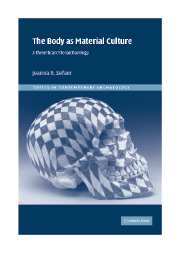4 - Material bodies
Published online by Cambridge University Press: 05 June 2012
Summary
The body is a most peculiar ‘thing’, for it is never quite reducible to being merely a thing; nor does it ever quite manage to rise above the status of thing.
Grosz 1994: xiThe separation between objects and people is deeply ingrained in the discipline. This distinction traditionally rests on a division between animate subjects that belong to the cultural world and inanimate objects that are part of the material world (Jones 2002a: 65). Accordingly, the living body is regarded as a person but as soon as the transition to death is made, the body becomes an object. Death not only describes an event horizon, but precipitates an ontological shift in the perception of the body that assumes a sudden change in its qualities.
If, however, as I have argued in the previous chapter, there need not be any sudden dramatic material transformation at the point of death and, in addition, the human skeleton may retain a social presence in death even though it becomes inanimate, then there exists some continuity on either side of the death event (Hallam et al. 1999). The porous character of the body means that it is difficult to identify clear boundaries between the body and the world. Furthermore, the divide between the living body as cultural and the skeletal body as natural cannot be sustained as bodies will always be both, albeit in different and changing configurations.
- Type
- Chapter
- Information
- The Body as Material CultureA Theoretical Osteoarchaeology, pp. 62 - 88Publisher: Cambridge University PressPrint publication year: 2006



